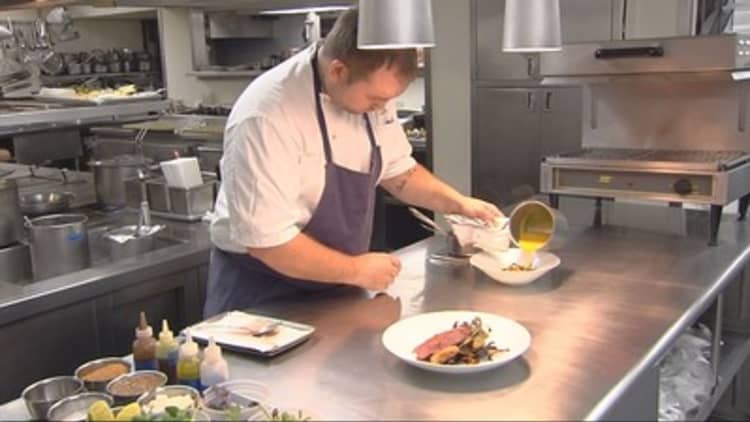
After the meal comes the math.
Dining out has long included figuring out the tip when the bill arrives, but that tradition could be changing with the number of restaurants testing "no-tipping" policies is growing.
In recent months, a handful of national chains have moved to dispose of gratuity. The owner of New York City's Craft explained to CNBC's "On the Money" that the move was done in part to make his staff's pay more rational. In many states, tipped employees receive hourly wages below the minimum because of gratuity. In theory, a no-tipping policy leaves waiters and waitresses less at the mercy of tips, which can fluctuate wildly if hourly wages are boosted as a result.
Moreover, Colicchio said reaction hasn't been what one might expect.
"I'm doing it because I think that I should be able to control, or at least compensate my staff," restaurateur Tom Colicchio explained in an interview with CNBC. He started lunch service — with no tipping — at his flagship Craft restaurant in New York City's Flatiron District, last month.
Read MoreJoe's Crab Shack tests no-tipping model
Colicchio, who is also lead judge on Bravo's "Top Chef" reality show, says the reaction from diners has been positive. "Everybody's fine. There's been very little pushback at all."
As a reason for the change, Colicchio cited research into tipping behavior that examined the correlation between the service people report receiving and the tips they give.
"We know through studies at Cornell University that the amount of money left in a tip has very little do with service, it has more to do with your accent, your race or your gender," he said. "So, I'd prefer to compensate my staff."
Colicchio founded his restaurant group, Crafted Hospitality in 2001. He now runs eight restaurants in New York, Florida, Nevada and California.
However, there was a modest tradeoff, he explained. "We raised our prices about 20 percent," Colicchio said. "It's just an increase in the menu price, and we actually removed the line on the credit card voucher for a gratuity."
Still, Colicchio added a line on the bottom of the Craft lunch menu that reads, "Hospitality is free! Gratuity is optional."
What about the waiters and waitresses whose tips are directly impacted by the policy? "I sat down with my servers and explained why I was doing it, what my intentions were," he said. Colicchio says he knows what all his servers have made in tips over the past three years.
"All tips are recorded, by the way. The days of putting the cash in your pocket is gone," Colicchio added. "It's all on a credit card. Our servers get paid in a paycheck, so we record everything."
Colicchio started his no-tipping policy at Craft on Oct. 1. That's about two weeks before his former restaurant partner, Danny Meyer, detailed his plans to eliminate tips. Meyer runs the upscale Union Square Hospitality Group's 13 restaurants in New York City.
Earlier this week, Joe's Crab Shack announced that it has been testing "no-tipping" at about 7 percent of its locations since August. As a result, the national seafood chain is raising both menu prices and hourly wages for its employees.
When asked by CNBC whether he was considering expanding the no-tipping policy beyond lunch to dinner at Craft, Colicchio said he was.
"And so, to the consumer, if we raise prices by 20 percent and the average person's tip is about 20 percent, it's a pass-through right to the server," the restaurateur said. "So, I'm not taking any of that money and putting it in my pocket. The only real negative is you're paying sales tax."
— "On the Money" airs on CNBC Saturday at 5:30 a.m. ET, or check listings for air times in local markets.




